Notre Dame Cathedral in Paris, architectural masterpiece on the banks of the Seine River
Notre Dame Cathedral in Paris with its timeless beauty is considered a symbol of magnificent France. This is definitely a sightseeing spot you should not miss on your trip to France
Notre Dame Cathedral in Paris, a timeless architectural symphony
Nestled on the small island of Ile de la Cité in the middle of the Seine River, Notre Dame Cathedral in Paris is a harmony between stone walls and light, painting a beautiful architectural picture of more than eight centuries. The Cathedral is an image associated with the magnificent capital Paris, attracting a large number of parishioners and visitors to enjoy it every year. 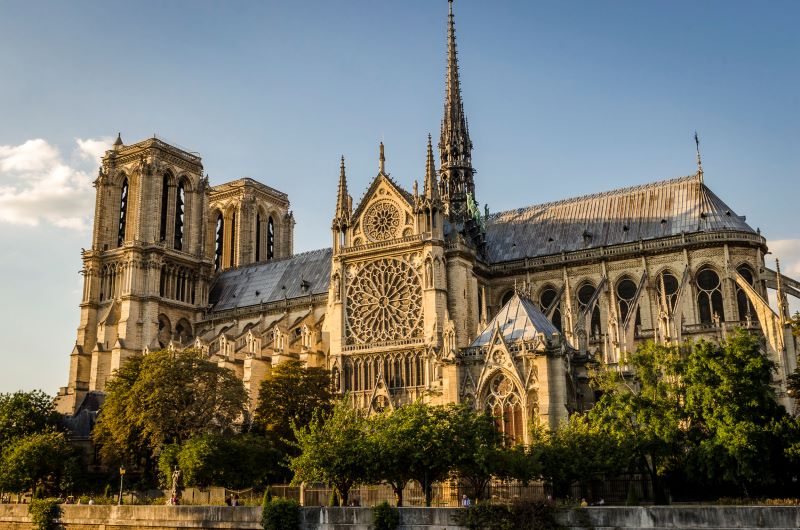
Overall, Notre Dame Cathedral in Paris is a beautiful building imbued with Gothic architecture. The Cathedral consists of two soaring twin towers, creating a majestic and sacred feeling for anyone who sees it for the first time.
Not only is it a symbolic image of Paris tourism, Notre Dame Cathedral is also considered a historical witness, a place to witness valuable moments over the past hundreds of years. The Cathedral was once the place where royal weddings were held, where King Napoleon Bonaparte was crowned, and where people celebrated major holidays together.
A witness to history in the heart of magnificent Paris
Officially starting construction in the 12th century, up to now, Notre Dame Cathedral in Paris has gone through more than 850 years accompanying the ups and downs of this city. In 1163, the first stone to build the Cathedral was laid on the island of Ile de la Cité in the middle of the Seine River, in the presence of Alexander III and King Louis VII. By 1350, the Cathedral was officially completed, and has become a symbol of France for the past hundred years. 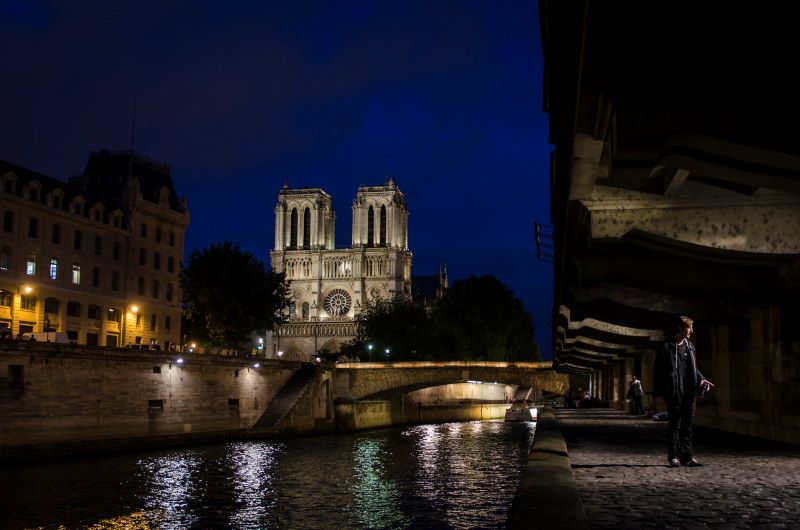
The reason why Notre Dame Cathedral is called a historical witness is because this place has witnessed the changes of this city The Cathedral was safe from bombs during the French Revolution, both fierce world wars and many other attacks.
The Cathedral is where many historical events of France took place. In 1431, King Henry VI ascended the throne here, followed by Napoleon in 1804. Next was the event that Pope Pius former President Francois Mitterrand, or the funeral of former French Prime Minister Charles De Gaulle in 1970.
What is special about the architecture of Notre Dame Cathedral in Paris?
Nestled peacefully on the banks of the gentle Seine River, the old Gothic beauty of Notre Dame Cathedral in Paris seems to be even more clearly expressed. The Cathedral is 130 meters long, 48 meters wide, 35 meters high and can accommodate up to 6,500 people.
The facade of the church is arranged in a balanced structure, with the highlight being three rose windows with glass paintings, recreating events in the Bible. When light shines through, the church space will light up with different colors, adding sparkle and magic to the whole. The roof of the church has statues, which are meant to remind sinners, ward off demons, and at the same time have the ability to catch rainwater and keep the foundation dry.
The highlight of the Cathedral is four huge pillars, at the top is a bell tower, in the center is a rose window with a statue of the Virgin Mary holding Baby Jesus, surrounded by angels. Right below are 28 statues of kings of 28 Juda dynasties before the time of Christ's coming to earth.
Notre Dame Cathedral in Paris has 3 gates, including Le Portail du Jugement Dernier (Last Judgment Day), the main gate. This gate is decorated with intricately carved statues and patterns, the most prominent being a painting recreating the scene of God's judgment day.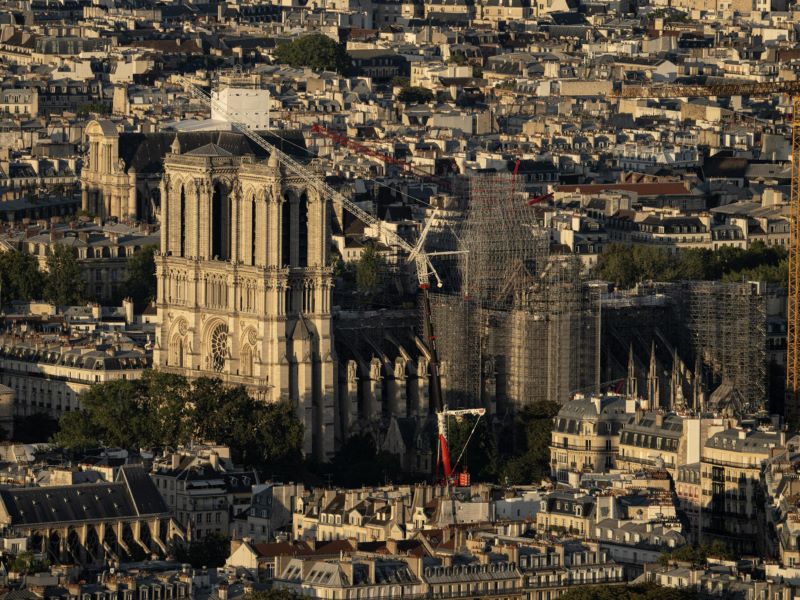
Le Portail de la Vierge (Virgin Mary) gate is decorated with sculptures representing the event of her return to heaven, and on the right is Le Portail Sainte-Anne, Saint Anne, or Mother of Mary. The bell tower of Notre Dame Cathedral in Paris is 96 meters high, with a total of 442 steps. At step 387 is a balcony radiating out to the North and South towers, an ideal point for people to observe the panorama from above. 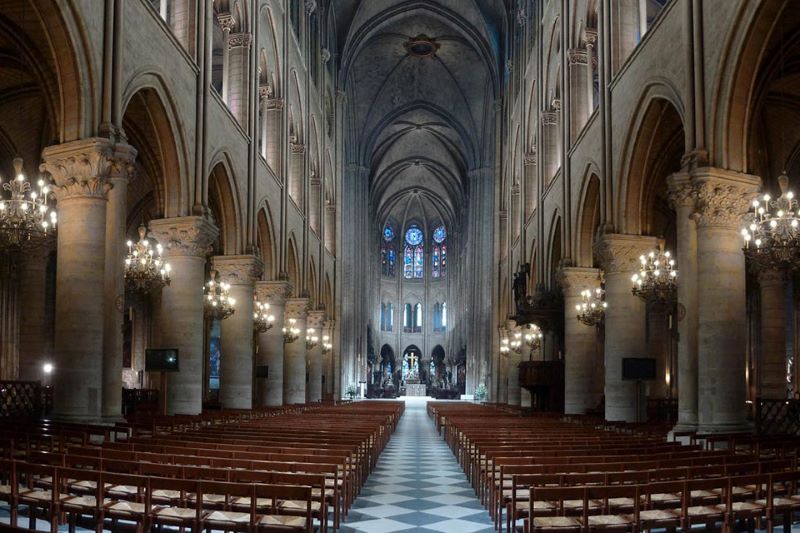
In the Holy Palace are two rows of columns with domed ceilings facing up, faithfully reproducing the French architectural style of the 13th century. The two rows of columns are exquisitely carved, creating a sacred feeling for anyone who sees them. Right in the Holy Palace there is also a special organ, made from 7,800 copper pipes of different sizes, implying the birth of melodious and captivating sounds.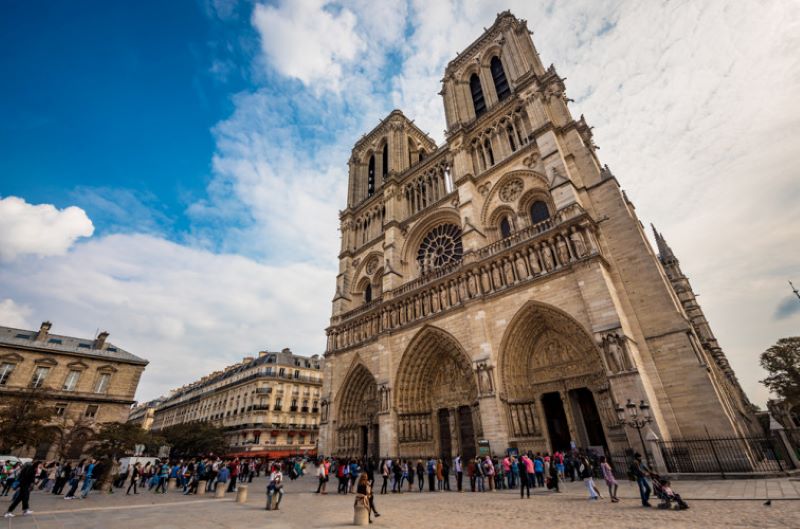
The famous Cathedral has three doors. If you enter from the West gate, you will be able to see a panoramic view of three large arches and two tall bell towers from here. Standing from the West gate, you will see on the archway a complex of statues of 28 kings of the Juda Dynasty along with a facade with intricately carved lines and bronze statues depicting the 12 apostles of God.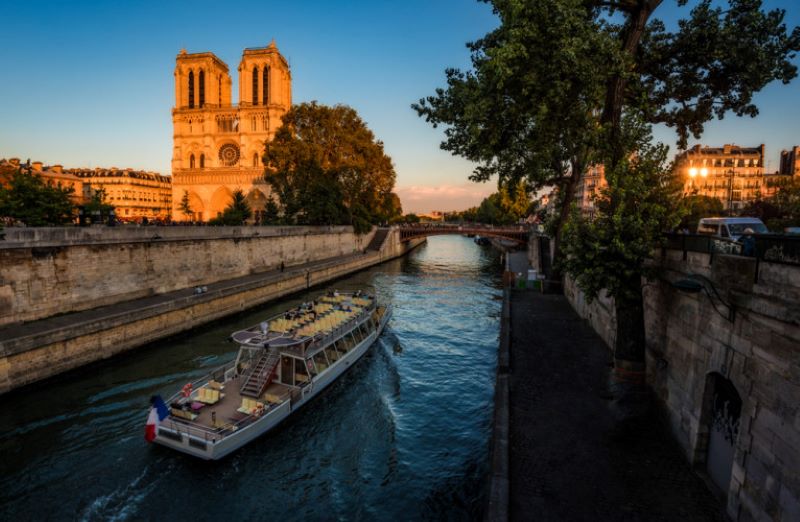 If you choose to enter from the South gate, you will have the opportunity to admire the largest Emmanuel bronze bell among the 10 at Notre Dame Cathedral in Paris. This is also an image that often appears in literary masterpieces, such as The Hunchback of Notre Dame by the great Victor Hugo. In particular, when standing from the South gate, you will also be able to observe a corner of the magnificent capital Paris from above, so wonderful, isn't it?
If you choose to enter from the South gate, you will have the opportunity to admire the largest Emmanuel bronze bell among the 10 at Notre Dame Cathedral in Paris. This is also an image that often appears in literary masterpieces, such as The Hunchback of Notre Dame by the great Victor Hugo. In particular, when standing from the South gate, you will also be able to observe a corner of the magnificent capital Paris from above, so wonderful, isn't it?






































![[LIVE] Engage2Earn: auspol follower rush](https://cdn.bulbapp.io/frontend/images/c1a761de-5ce9-4e9b-b5b3-dc009e60bfa8/1)


